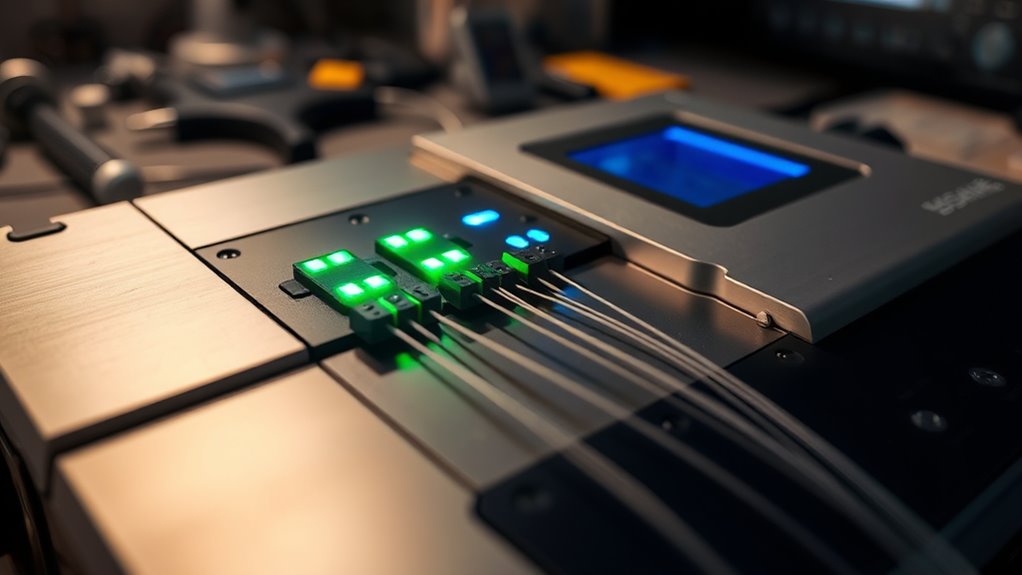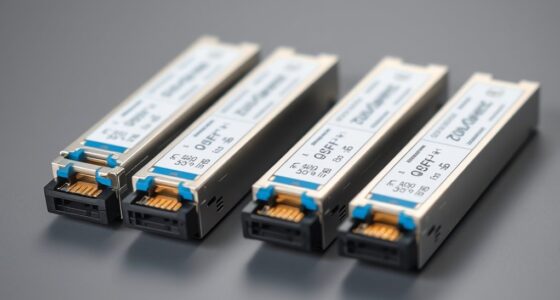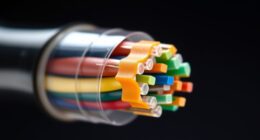If you’re looking for the best fusion splicers with core alignment technology, I recommend models like the AI-9, FX39, and FS-60E, which offer high precision, fast splicing times, and low-loss connections. These devices are equipped with multiple motors, advanced image processing, and compatibility with various fiber types, ensuring reliable, professional results in the field. Keep exploring further to find the perfect fit for your specific projects and needs.
Key Takeaways
- Fusion splicers with multi-motor core alignment technology ensure minimal splice loss and high precision for various fiber types.
- Look for models with high-resolution CMOS cameras and magnification up to 300x for accurate fiber positioning.
- Prioritize devices offering fast splicing times (around 6-8 seconds) and low loss (as low as 0.01dB) for efficiency.
- Consider portable, rugged designs with long battery life (over 160 cycles) suitable for field deployment.
- Compatibility with multiple fiber standards (SM, MM, G.652, G.657, G.655) ensures versatility across different projects.
SM&MM Automatic Optical Fiber Fusion Splicer & Cleaver Kit (Ai-9)

If you’re looking for a reliable, cost-effective fusion splicer that combines core alignment technology with versatile compatibility, the SM&MM Ai-9 is an excellent choice. It features a 3-in-1 fiber holder compatible with SM, MM, bare fibers, pigtails, and multi-fiber cables, supporting cladding diameters from 80-150μm. The adjustable cleave length and high-precision splicing ensure minimal loss—just 0.025dB for SM and even lower for MM fibers. Its built-in power meter, fault locator, and high-res 5-inch screen make operation straightforward. Designed for durability, it handles over 50,000 splices, making it ideal for professionals seeking quality at a budget-friendly price.
Best For: professionals and technicians seeking a reliable, budget-friendly fusion splicer for SM, MM, and multi-fiber cables with high precision and durability.
Pros:
- Supports a wide range of fiber types and diameters with versatile 3-in-1 fiber holder.
- Features core alignment technology for minimal splice loss and high-quality results.
- Built-in power meter, fault locator, and high-resolution screen enhance ease of use and functionality.
Cons:
- Automatic splice recognition may struggle with bad cleaves, requiring manual checks.
- Some users experience fiber breakage during heat-shrink application and minor charging issues.
- The included stool is small and may not be suitable for all users, and frequent refills of the alcohol dispenser are needed.
KOMSHINE Fiber Fusion Splicer FX39 with 6 Motors

The KOMSHINE Fiber Fusion Splicer FX39 with 6 Motors stands out as an ideal choice for telecom technicians and field professionals who need precise, high-speed splicing in challenging environments. Its six-motor core alignment technology ensures highly accurate splices, with average losses of just 0.01dB for multimode fibers. The device is portable, weighing around 2.25kg with battery, and features a 4.3-inch color LCD touch screen for easy operation. It offers fast splicing (6 seconds) and heating (16 seconds), supports various fiber types, and can handle 5000 electrode cycles. Built for durability, it performs reliably even in harsh conditions, making it a top tool for demanding field projects.
Best For: telecom technicians and field professionals seeking a portable, high-precision fiber splicer capable of handling diverse fiber types in challenging outdoor environments.
Pros:
- Fast splicing time of just 6 seconds with a 16-second heating cycle, enhancing efficiency
- Six-motor core alignment technology ensures highly accurate, low-loss splices (average 0.01dB for multimode fibers)
- Durable, lightweight design (~2.25kg with battery) suitable for demanding field conditions
Cons:
- Limited support for ribbon fiber splicing and lack of specific ribbon fiber attachment tools
- Electrode maintenance required after approximately 1000-5000 splices, which may affect long-term operational costs
- Slightly bulky size for some users, potentially challenging for extended portabilit
Fusion Splicer AI-6A Fiber Optical Fusion Splicer with 8S Splicing & 18S Heating

For professionals seeking quick, precise fiber splicing in challenging environments, the Fusion Splicer AI-6A with core alignment technology stands out. This fully automatic, portable device features six motors, making it ideal for long-distance fiber welding in harsh conditions like high altitudes or extreme cold. It offers rapid 8-second fusion and 18-second heating times, ensuring efficiency. Its high-precision core alignment reduces splicing loss, and the 300x magnification allows detailed inspection. With a 5200mAh battery supporting around 160 cycles and smart app connectivity, the AI-6A combines durability, speed, and accuracy for demanding fiber optic installations.
Best For: professionals needing rapid, precise fiber splicing and heating in challenging environments such as high altitudes, deserts, and cold climates.
Pros:
- Fully automatic with core alignment technology for high accuracy and low splicing loss.
- Rapid fusion and heating times (8s and 18s) for increased efficiency.
- Long-lasting battery supporting approximately 160 cycles with fast charging.
Cons:
- May be more expensive compared to manual or less advanced splicers.
- Requires smartphone app for full functionality, which may not be compatible with all devices.
- Slightly heavier and bulkier due to its robust, high-capacity design.
Komshine FX39 Fusion Splicer Fiber Optical with Large Battery and Power Meter
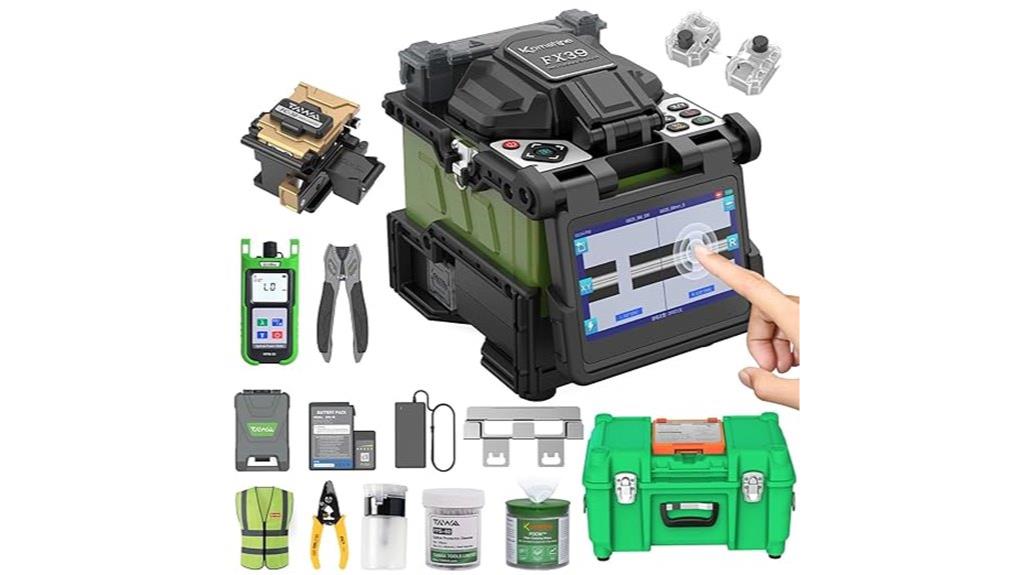
Designed for professionals demanding high precision and efficiency, the Komshine FX39 Fusion Splicer stands out with its core alignment technology, enabling rapid splicing with just 6 seconds and quick 16-second heating. Its 4.3-inch color LCD display makes operation straightforward, supporting a wide range of fiber types, including SM, MM, bare fiber, and pigtails. The large 7800mAh battery allows for about 400 splicing and heating cycles per charge, perfect for fieldwork. With support for multiple standards (G.652, G.657, G.651, G.655) and a power meter with seven wavelengths, this device combines versatility, speed, and durability for high-quality fiber connections.
Best For: professionals and technicians requiring high-precision, efficient fiber splicing in field environments, such as FTTH deployments and telecom projects.
Pros:
- Rapid splicing and heating times (6s and 16s), increasing workflow efficiency
- Large 7800mAh battery supports approximately 400 cycles, ideal for extended field use
- Supports multiple fiber types and standards, offering versatility for various projects
Cons:
- Heavier weight with battery (2.25kg), which may impact portability for some users
- Additional accessories like electrodes and power meter are optional and may incur extra costs
- Requires technical knowledge for optimal operation and support, which may necessitate training
Signal Fire AI-9 Fusion Splicer for Fiber Optic Welding
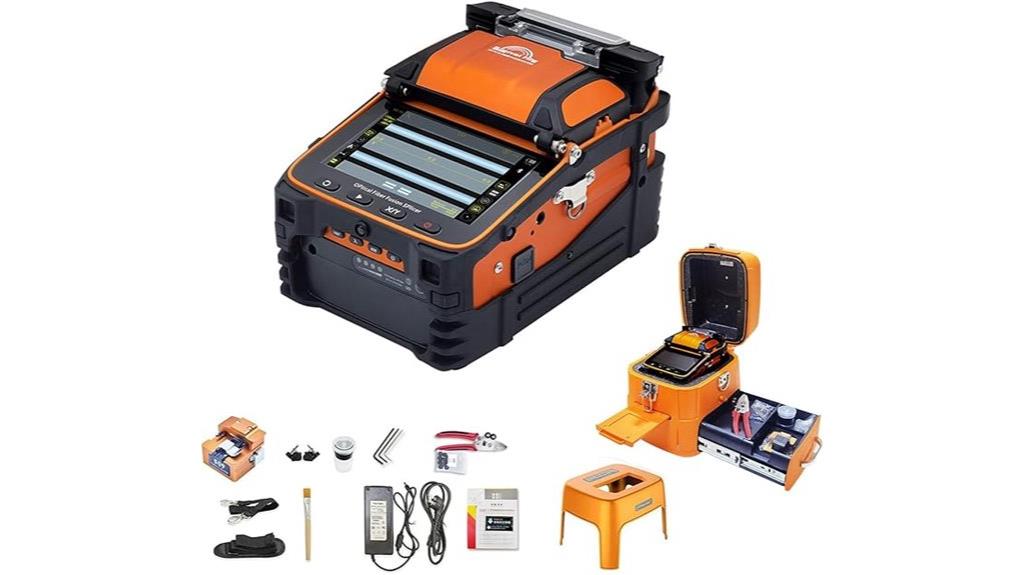
If you’re seeking a fusion splicer that delivers rapid, precise fiber optic connections, the Signal Fire AI-9 stands out thanks to its core alignment technology. It offers a quick 5-second splice time and a 15-second heating cycle, supporting about 260 operations continuously. The device features a high-resolution LCD screen with magnification up to 300x, ensuring accurate fiber alignment, along with a built-in power meter and VFL for measuring connection loss and verifying transmission quality. Its versatile 3-in-1 fiber holder supports various fiber types, and a robust battery provides up to 3.5 hours of operation, making it ideal for both fieldwork and professional use.
Best For: technicians and professionals seeking fast, reliable, and precise fiber optic splicing in field or workshop environments.
Pros:
- Rapid 5-second splice time and 15-second heating cycle for high efficiency.
- High-resolution LCD with magnification up to 300x for accurate fiber alignment.
- Supports multiple fiber types and includes a built-in power meter and VFL for comprehensive testing.
Cons:
- Regular maintenance and calibration are necessary to ensure optimal performance.
- Bluetooth connectivity can be unstable, affecting remote monitoring and control.
- Some users experience issues with hot melt shrinking tubes damaging fiber jackets over time.
Fusion Splicer AI-5A Fiber Optical Fusion Splicer

The Fusion Splicer AI-5A stands out as the ideal choice for professionals who need high-precision fiber splicing in challenging environments. Its compact, lightweight design makes it easy to transport and operate in the field. Equipped with four motors and core alignment technology, it offers micrometer-level accuracy, ensuring low splicing loss. The device supports long-distance welding and performs reliably in harsh conditions like high altitudes and extreme cold. With fast splicing and heating times, a high-capacity battery, and smart connectivity features, the AI-5A delivers efficiency, durability, and precise results wherever you work.
Best For: professionals requiring high-precision fiber splicing in challenging environments such as high altitudes, deserts, and extreme cold conditions.
Pros:
- Supports long-distance fiber welding with high accuracy through core alignment technology
- Compact, lightweight design with a durable build suitable for field portability
- Fast splicing (8 seconds) and heating (18 seconds) times enhance operational efficiency
Cons:
- Limited to approximately 160 splicing and heating cycles per full charge, requiring careful power management
- May have a learning curve for users unfamiliar with advanced fiber splicing technology
- Connectivity features depend on mobile app compatibility, which could vary across devices
VEVOR Fiber Fusion Splicer with LCD Screen and Battery

For professionals seeking fast, precise fiber splicing in the field, the VEVOR Fiber Fusion Splicer with LCD screen and battery stands out thanks to its high-precision core alignment technology. It features six high-precision motors that enable rapid splicing in just six seconds and quick heating in 13 seconds. With a 5-inch HD LCD display offering multiple viewing modes and up to 1100x magnification, I can clearly see fiber cores for accurate alignment. Its 7800mAh battery provides over 260 cycles, and a USB port supports data transfer and device charging. Built with durable materials, it’s lightweight, shockproof, and perfect for demanding environments.
Best For: professionals and technicians who need fast, accurate fiber splicing in the field under demanding conditions.
Pros:
- High-precision core alignment with six motors for rapid, low-loss splicing
- Large 5-inch HD LCD with multiple viewing modes for clear, detailed fiber visualization
- Long-lasting 7800mAh battery supporting over 260 cycles and versatile data connectivity
Cons:
- May be relatively expensive compared to basic splicing tools
- Requires training to fully utilize advanced display and multi-motor technology
- Bulkier accessories and case might be less convenient for ultra-lightweight fieldwork
Fusion Splicer AI-5 Toolbox Kit with Auto Focus & 4 Motor Core Alignment
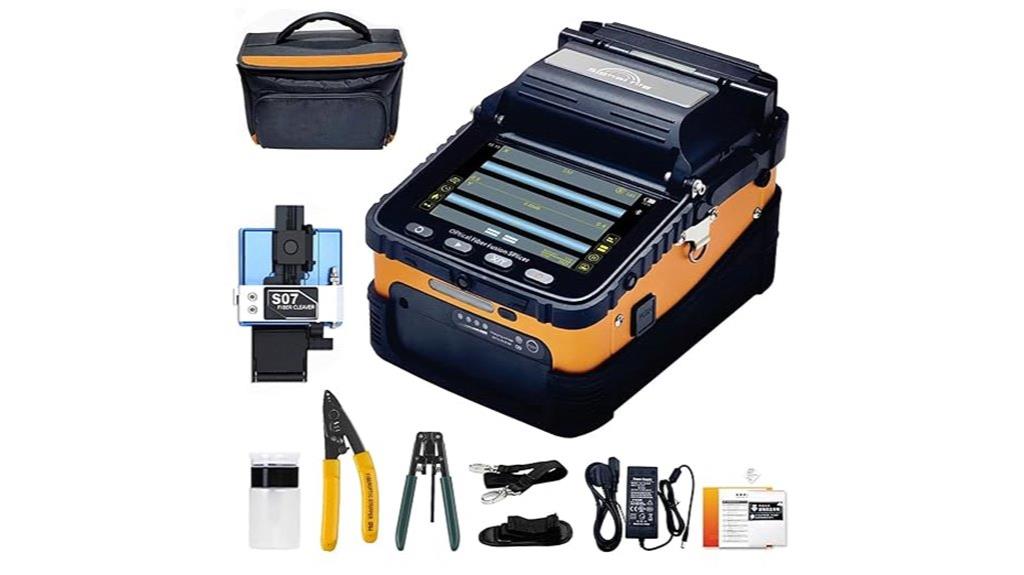
When precise and efficient fiber splicing is essential, the Fusion Splicer AI-5 Toolbox Kit with Auto Focus and 4 Motor Core Alignment stands out as an ideal choice. It features core alignment technology with automatic focus and four motors, ensuring high-precision splicing while minimizing loss. Splicing takes only 8 seconds, with quick heating in 18 seconds, thanks to its high-speed motor and advanced design. The large 5200 mAh battery supports around 160 cycles, and the 5-inch LCD display offers detailed focus control. Plus, its smart connectivity via mobile app makes data management easy, making it a versatile solution for demanding fiber optic projects.
Best For: professionals and technicians who require high-precision, fast, and reliable fiber optic splicing solutions for demanding projects.
Pros:
- Rapid splicing in just 8 seconds with high accuracy due to core alignment technology and automatic focus
- Long-lasting 5200 mAh battery supporting approximately 160 splicing and heating cycles
- User-friendly 5-inch LCD display with detailed focus control and smart mobile app connectivity for data management
Cons:
- Higher initial cost compared to basic splicing machines
- Slightly bulky design may be less portable for on-the-go field work
- Requires a power source for charging, which might be a constraint in remote locations
KOMSHINE Fiber Fusion Splicer FX39 with 6 Motors
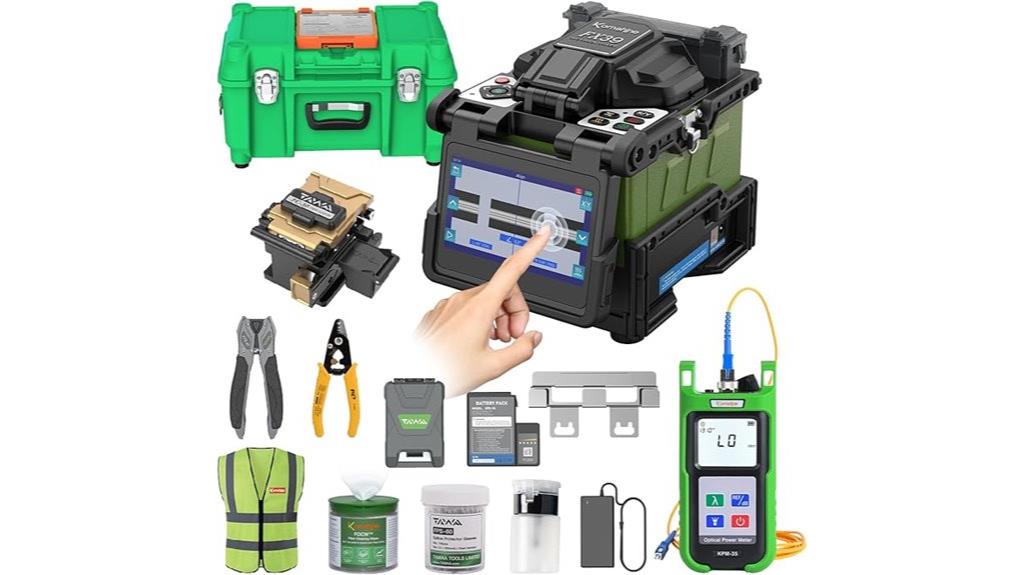
If you’re working on multi-FTTH projects that demand precise fiber alignment, the KOMSHINE FX39 with 6-motor core alignment technology is an excellent choice. This portable device offers fast splicing—just 6 seconds—and quick heating in 16 seconds, making it ideal for fieldwork. Its 4.3-inch color LCD touch screen ensures easy operation, while the six motors provide highly accurate alignment, resulting in minimal splice loss—around 0.01dB for MM fibers. With a durable design, support for various fiber types, and a long-lasting battery capable of 400 splices, it’s reliable for high-volume, professional splicing tasks.
Best For: professionals performing high-volume, multi-FTTH fiber splicing in the field who need quick, precise, and reliable splicing capabilities.
Pros:
- Fast splicing time of just 6 seconds and heating in 16 seconds, increasing efficiency.
- Six-motor core alignment technology ensures highly accurate fiber positioning with minimal splice loss.
- Durable, lightweight design with a long-lasting battery supports extended field operations and various fiber types.
Cons:
- Limited to single-fiber splicing; not suitable for ribbon fiber or ribbon splicing applications.
- Electrode maintenance and recalibration are required after around 1000-5000 splices, which may impact workflow.
- Slightly bulky size may be less portable for users needing ultra-compact equipment.
Komshine FX39 Fusion Splicer for Fiber Optic with Touch Screen and 7800mAh Battery

The Komshine FX39 Fusion Splicer stands out as an ideal choice for professionals engaged in high-precision fiber optic projects, thanks to its advanced core alignment technology. It offers rapid splicing in just 6 seconds and quick 16-second heating, boosting efficiency. The device supports multiple fiber types, including SM, MM, bare fiber, and pigtails, with compatibility across standards like G.652 and G.657. Its 7800mAh battery guarantees about 400 cycles per charge, making it perfect for fieldwork. The 4.3-inch LCD touch screen provides easy operation, while robust electrodes support up to 5000 cycles, ensuring durability for demanding projects.
Best For: Professional technicians and field engineers requiring high-precision, fast, and durable fiber optic splicing solutions for various fiber types and standards.
Pros:
- Supports rapid splicing (6s) and heating (16s) for increased efficiency
- Compatible with multiple fiber types and standards, offering versatility
- Long electrode lifespan supporting up to 5000 cycles, reducing maintenance costs
Cons:
- Heavier weight with battery (2.25kg), which may impact portability during extended field use
- Requires technical knowledge for optimal operation and setup
- Accessories such as fiber optic electrodes and power meters are shipped randomly, potentially leading to additional ordering delays
VEVOR Fiber Fusion Splicer with LCD Screen and Battery
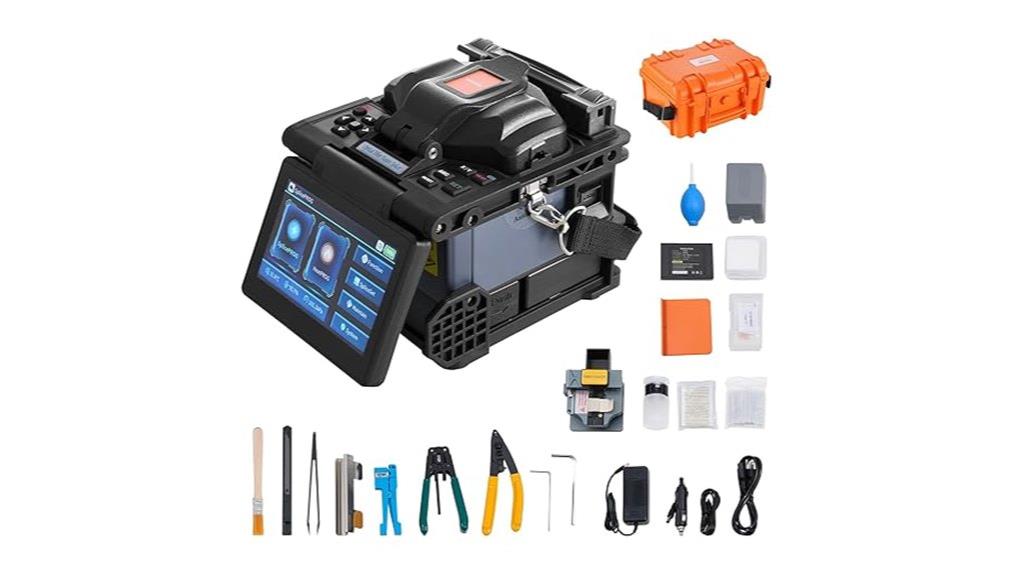
Designed for field technicians who need quick, precise fiber splicing, the VEVOR Fiber Fusion Splicer with LCD screen and battery stands out with its high-precision core alignment technology. It features six motors that enable rapid splicing in just six seconds and quick heating in 13 seconds, with fusion loss as low as 0.01 dB for multimode fibers. Its 5-inch HD LCD display offers multiple modes, including independent magnification and double-click zoom for detailed fiber core visualization. Powered by a 7800mAh battery, it supports over 260 cycles per charge. Its durable, lightweight design is ideal for harsh environments, and the complete kit guarantees efficient fieldwork.
Best For: field technicians and fiber optic professionals who require quick, precise splicing in challenging environments.
Pros:
- High-precision core alignment with rapid splicing (6 seconds) and quick heating (13 seconds).
- Clear, detailed visualization with a 5-inch HD LCD screen and multiple display modes.
- Long-lasting 7800mAh battery supporting over 260 cycles and versatile connectivity options.
Cons:
- May be heavier or bulkier compared to simpler, manual splicing tools.
- Requires familiarity with advanced features and display modes for optimal use.
- The complete kit, while comprehensive, may be costly for casual or occasional users.
VEVOR Fiber Fusion Splicer with Touch Screen and 7800mAh Battery
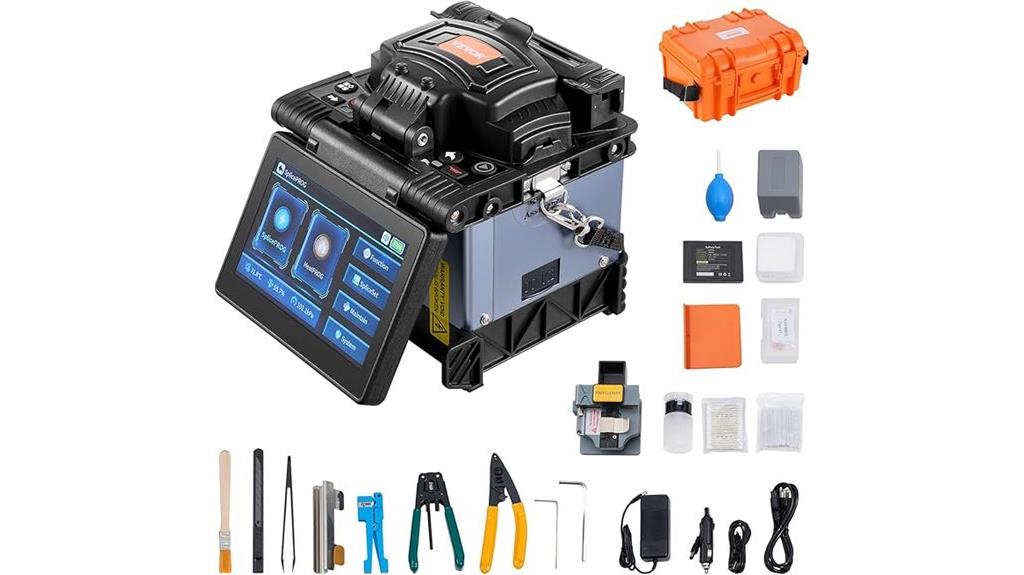
For professionals seeking fast, precise fiber splicing in the field, the VEVOR Fiber Fusion Splicer with Touch Screen and 7800mAh Battery stands out. Its high-precision 6 motors enable quick splicing in just 6 seconds and rapid heating in 13 seconds, with fusion loss as low as 0.01 dB for MM fibers. The 5-inch HD touch screen offers multiple viewing modes, including independent magnification and simultaneous X/Y core visualization. Powered by a durable 7800mAh battery, it supports over 260 cycles per charge. Its rugged build withstands harsh environments, and the complete kit ensures you’re ready for any fiber optic task on the go.
Best For: professionals and technicians who need fast, accurate fiber optic splicing in demanding field environments.
Pros:
- Rapid splicing and heating times (6 seconds and 13 seconds respectively) improve efficiency.
- Low fusion loss as minimal as 0.01 dB for MM fibers ensures high-quality connections.
- Durable, lightweight design with a high-capacity battery supports extended outdoor use and harsh conditions.
Cons:
- The device’s advanced features may have a steeper learning curve for new users.
- The complete kit, while comprehensive, may be bulky for very tight space operations.
- Dependence on battery life could be a limitation in prolonged field tasks without access to charging.
DECAAT FTTH Optical Fiber Fusion Splicer
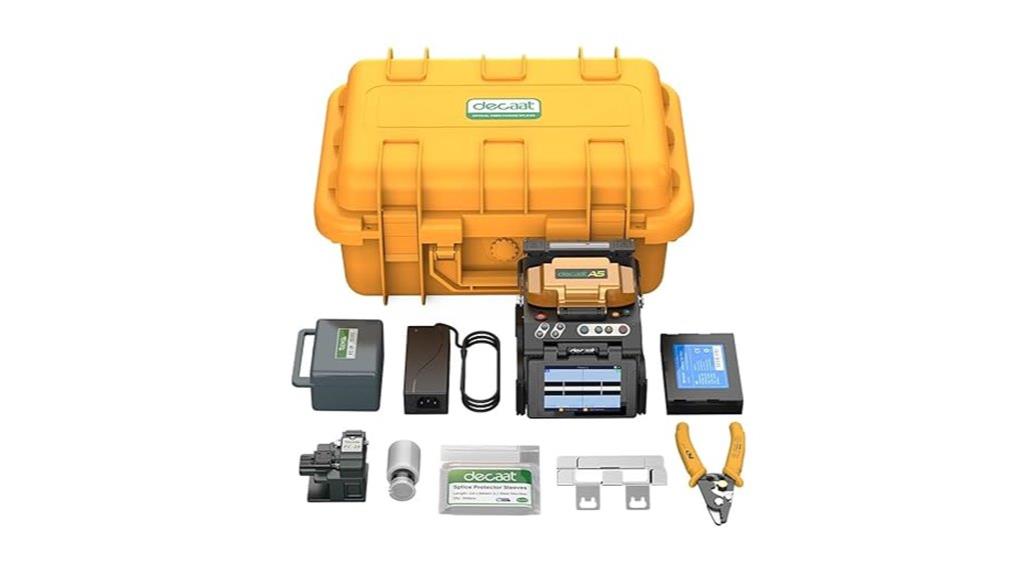
If you’re seeking a fusion splicer that combines speed, accuracy, and durability, the DECAAT FTTH Optical Fiber Fusion Splicer stands out as an ideal choice. It features 8S splicing and 18S heating times, ensuring low splice loss and fast turnaround. Automatic core alignment and arc compensation deliver consistent, precise results, while the high-speed motor and CPU boost efficiency. Its 3.5-inch high-res color display clearly shows fiber cores, and built-in LEDs enhance visibility. Designed to be compact, waterproof, and dustproof, it’s suitable for tough environments. Plus, with storage for thousands of records, it simplifies data management, making it perfect for demanding fiber optic projects.
Best For: professional fiber optic technicians and installation teams needing a durable, efficient fusion splicer for high-precision, large-volume splicing projects.
Pros:
- Rapid splicing and heating times (8S/18S) for increased productivity
- Automatic core alignment and arc compensation ensure consistent, high-quality splices
- Robust, waterproof, and dustproof design suitable for challenging environments
Cons:
- May have a higher initial cost compared to basic splicer models
- Requires training to fully utilize advanced features and automation
- Large storage capacity might be unnecessary for small-scale or occasional users
Core to Core Alignment Arc Optical Fiber Fusion Splicer (SS411F-211)
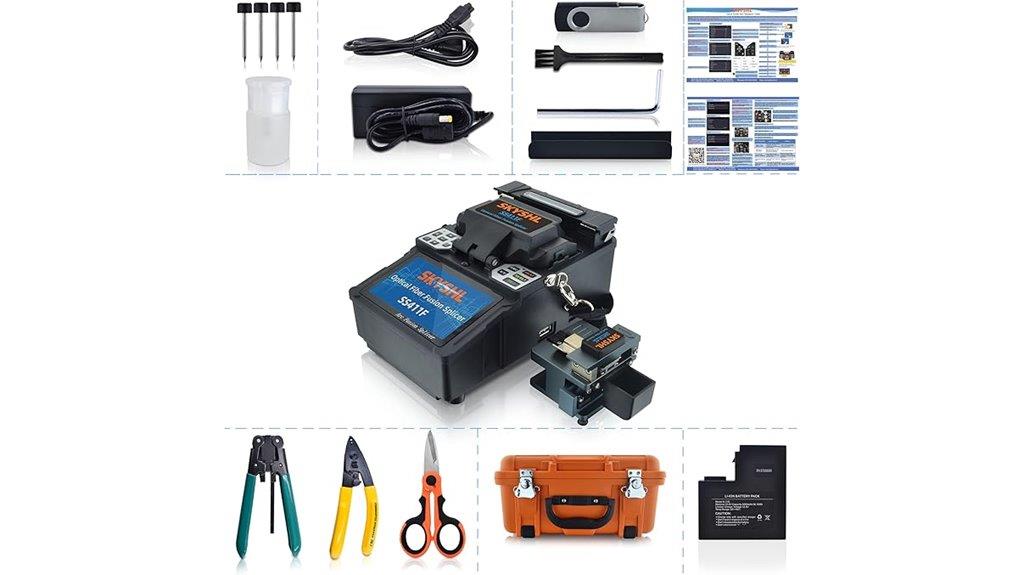
The Core to Core Alignment Arc Optical Fiber Fusion Splicer (SS411F-211) stands out as the ideal choice for professionals demanding high precision in fiber optic splicing. Its advanced image processing, high-precision CMOS camera, and CNC-machined components guarantee accurate, reliable connections. Compact and lightweight, it’s designed for portability and ease of use, with a user-friendly 4.3-inch TFT touch screen. Splicing is swift—just 6 seconds—while automatic environmental compensation maintains high-quality results even in variable conditions. Complete with accessories like electrodes and a fiber cleaver, this splicer supports efficient, consistent, and durable fiber connections for data centers, metro networks, and FTTx deployments.
Best For: Professional fiber optic technicians and network installers requiring high-precision, reliable, and portable fusion splicing solutions for data centers, metro networks, LAN, and FTTx projects.
Pros:
- Rapid splicing and heating times (6 seconds for splicing, 15 seconds for heating) enhance workflow efficiency.
- Automatic environmental compensation and focus functions ensure consistent high-quality splices in variable conditions.
- Compact, lightweight design with a user-friendly 4.3-inch touch screen makes it highly portable and easy to operate.
Cons:
- Limited to fiber types compatible with core-to-core alignment technology, which may not suit all fiber variations.
- Battery life averaging 10 years may require replacement or charging in extended field operations.
- The device’s advanced features and accessories may come at a higher cost compared to simpler splicers.
Fiber Optic Fusion Splicer FS-60E

The Fiber Optic Fusion Splicer FS-60E stands out for its advanced core alignment technology, making it an ideal choice for technicians demanding high precision and efficiency in fiber splicing. It features six independent motors controlling X/Y translation, Z-axis height, rotation, and focusing, ensuring highly accurate core-to-core alignment. Its sophisticated image processing captures clear fiber core images, supporting rapid, precise splicing within just 8 seconds and heating in 18 seconds. The 5-inch capacitive touch screen allows easy operation, while built-in fault detection tools like the VFL and optical power meter speed up troubleshooting. Its durable battery and multi-language support make it perfect for field use and diverse user needs.
Best For: technicians and field engineers requiring high-precision, efficient fiber splicing and maintenance in fiber optic network construction and repair.
Pros:
- Equipped with six independent motors for highly accurate core alignment and fast, precise splicing within 8 seconds.
- Built-in fault detection tools like VFL and optical power meter for quick troubleshooting.
- User-friendly 5-inch capacitive touch screen with multi-language support and durable battery for field operations.
Cons:
- May be more expensive compared to basic fusion splicers, reflecting its advanced features.
- The complexity of features might require training for new users to maximize functionality.
- Large data storage and high-resolution imaging could impact device size and weight, affecting portability slightly.
Factors to Consider When Choosing Fusion Splicer With Core Alignment

When selecting a fusion splicer with core alignment, I consider factors like splicing speed and efficiency to guarantee productivity. Compatibility with different fiber types and ease of use are also key, so I can work smoothly without hassle. Additionally, I focus on precision technology, power, and battery life to assure reliable, high-quality connections over time.
Splicing Speed and Efficiency
Choosing a fusion splicer with core alignment technology means prioritizing speed and efficiency, especially for high-volume fiber optic projects. Faster splicing times, like 6-8 seconds, markedly boost productivity by reducing overall project duration. A splicer with a heating cycle of 15-18 seconds allows for quick termination, further speeding up deployment. High splicing efficiency minimizes fiber handling, lowering the risk of misalignment and ensuring consistent quality. Multi-motor core alignment technology ensures precise fiber positioning, leading to lower splice loss and higher throughput. Support for rapid, automated core alignment streamlines workflow, decreases downtime, and enhances field repair speed. These features collectively maximize efficiency, making your project faster, smoother, and more reliable.
Compatibility With Fiber Types
Selecting a fusion splicer that supports the right core alignment technology depends heavily on the fiber types you’ll be working with. You need to guarantee the device is compatible with common fibers like single-mode (SM), multimode (MM), dispersion-shifted (DS), NZDS, or specialty fibers. Check if the splicer can accommodate the fiber’s cladding diameter, usually between 80-150μm, for proper alignment and low splice loss. If your project involves complex cabling, verify compatibility with multi-fiber or ribbon fibers using appropriate holders or adapters. Additionally, confirm support for fiber standards such as G.652, G.657, G.651, or G.655 to ensure peak performance. Finally, consider whether the device can handle various cable types, including bare fiber, pigtails, or rubber-insulated cables, for versatility.
Ease of Operation
An easy-to-operate fusion splicer features a user-friendly interface with intuitive controls like touchscreens or simple buttons, making setup quick and straightforward. Automated functions such as auto-focusing, arc adjustment, and fiber recognition help reduce manual effort, ensuring a smooth splicing process. High-resolution displays with magnification up to 300x allow me to visually verify fiber alignment easily, leading to precise splices without extensive training. Support for multiple languages and adjustable parameters through mobile apps or onboard menus makes the device accessible to operators of varying skill levels. Built-in diagnostic and calibration tools simplify maintenance, keeping the splicer in excellent condition without requiring advanced technical knowledge. Overall, a user-centric design ensures efficient operation and consistent, high-quality splicing results.
Power and Battery Life
A fusion splicer’s power and battery life directly impact its performance in the field, especially during extended work sessions. Longer battery life means I can perform more splicing and heating cycles without needing to recharge, which is crucial for remote or busy sites. Devices with high-capacity batteries, like 7800mAh, support over 400 cycles per full charge, ensuring reliable operation. Quick recharge times, typically under 3.5 hours, help me stay efficient during continuous work. I also look for models with robust batteries and easy replacement options, since battery performance can degrade over time. Integrated power management features are a big plus, as they optimize usage and keep the device running smoothly even in demanding environments.
Precision and Alignment Technology
When choosing a fusion splicer with core alignment technology, I focus on the system’s ability to precisely position fiber cores, as this directly impacts splice quality. High-precision image processing and multiple motors work together to align cores accurately, often achieving splice losses as low as 0.01dB. This results in superior signal transmission. Multi-motor systems enable fast, automated fiber positioning, saving time and boosting efficiency. Advanced models also automatically monitor environmental conditions, adjusting arc parameters to maintain ideal core alignment. Additionally, high magnification viewing—up to 300x or more—allows me to verify core alignment in real-time, ensuring high-quality splices. Prioritizing these features helps me select a splicer that guarantees precise, reliable connections with minimal signal loss.
Durability and Build Quality
Durability and build quality are essential considerations because fusion splicers often operate in challenging environments where exposure to dust, moisture, and rough handling is common. A sturdy device typically features rugged materials like metal CNC-machined parts and shockproof casings, ensuring longevity. High-quality models have sealed components and corrosion-resistant coatings to withstand dust, humidity, and temperature changes. The internal components, including batteries, are designed for high cycle life, enabling thousands of splices before maintenance. Reinforced fiber holders and protective covers help prevent mechanical damage during frequent use in the field. Reliable build quality also involves moisture-proof interfaces and temperature compensation, ensuring consistent performance over time despite demanding conditions. Choosing a durable fusion splicer guarantees long-term dependability and reduces downtime.
Support and Maintenance Services
Choosing the right fusion splicer with core alignment technology requires careful consideration of the support and maintenance services offered by the manufacturer. I look for extensive technical support that handles troubleshooting, calibration, and repairs to keep my splicer performing at its best. It’s crucial to verify that replacement parts like electrodes, fiber holders, and cleavers are readily available, reducing downtime and extending the device’s lifespan. I also consider whether the manufacturer provides regular maintenance, calibration, and training to ensure my team stays skilled and the equipment remains accurate. Additionally, I pay attention to warranty coverage, especially if it includes on-site repairs or replacements, to protect my investment long-term. Accessible customer support through multiple channels, with a reputation for prompt assistance, is also a key factor in my decision.
Frequently Asked Questions
What Is the Maximum Fiber Core Diameter Compatible With Core Alignment Splicers?
The maximum fiber core diameter compatible with core alignment splicers is typically around 125 micrometers, which is standard for most single-mode and multimode fibers. I’ve found that these splicers are designed to handle fibers within this range effectively, ensuring precise alignment and minimal signal loss. If you’re working with larger or specialty fibers, double-check the splicer’s specifications to confirm compatibility, but generally, 125 micrometers is the limit.
How Does Core Alignment Technology Improve Splice Loss Accuracy?
Think of core alignment technology as a skilled archer perfectly aligning their shot. It improves splice loss accuracy by precisely aligning the fiber cores, minimizing gaps and misalignments. This guarantees light passes seamlessly through the splice, reducing signal loss. I’ve seen this in action—better alignment means more reliable connections, less signal degradation, and ultimately, a more efficient and durable fiber optic network.
Are Core Alignment Splicers Suitable for All Fiber Types and Sizes?
Yes, core alignment splicers are suitable for most fiber types and sizes. I’ve used them on single-mode, multi-mode, and even specialty fibers with excellent results. Their precise alignment technology adapts well to different fiber diameters, guaranteeing minimal loss. However, I always double-check fiber compatibility and manufacturer recommendations to assure maximum performance. Overall, core alignment splicers offer versatility and reliability across a wide range of fiber applications.
What Maintenance Is Required for Optimal Core Alignment Splicer Performance?
I keep my core alignment splicer in top shape by performing regular cleanings and calibrations. Just like tuning a musical instrument, it ensures precise connections. I also replace consumables like electrodes and cleavers as needed. Checking for firmware updates keeps it running smoothly. Staying attentive to these maintenance steps helps me avoid errors and guarantees reliable, high-quality splices every time.
How Do Core Alignment Splicers Handle Splicing in Harsh Environmental Conditions?
Core alignment splicers are built to handle tough environments by featuring robust enclosures, sealed designs, and temperature compensation. I guarantee I use the protective covers and carry the splicer in a padded case to shield it from dust, dirt, and moisture. Additionally, I regularly calibrate and maintain the device, which helps it perform accurately even in harsh conditions, ensuring reliable splicing every time.
Conclusion
I’ve found that choosing the right fusion splicer with core alignment technology genuinely makes a difference in fiber connection precision. It’s not just a theory—these splicers improve efficiency and reduce errors, especially for demanding projects. By investing in a reliable model, you’re more likely to achieve seamless, durable connections. So, trust the technology, do your research, and you’ll see how much smoother your fiber optic work becomes. It’s a game-changer I can personally vouch for.
